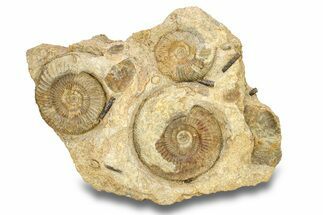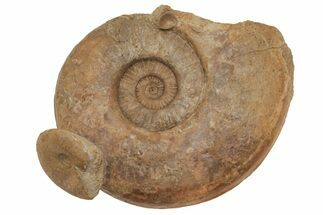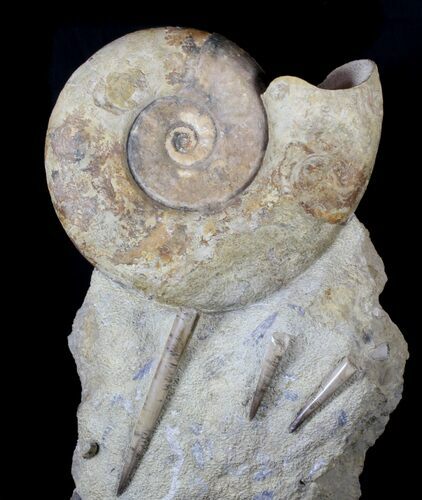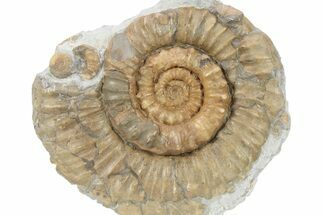This Specimen has been sold.
12" Ammonite (Euhoploceras) With Belemnites - Dorset, England
Please note: While we typically ship out material within 2 business days there will be a delay of approximately 4-5 days before we can ship this specimen. It's part of a lot of material currently in transit back to our primary shipping warehouse.
This is a very displayable piece from Dorset, England featuring a large, 12" wide Euhoploceras marginatum ammonite and a cluster of naturally associated Belemnites (Passaloteuthis sp). The entire block of limestone measures 18.2" high, is nicely prepared and displays well standing up on a flat surface. The belemnites, the largest of which is 7" long have been polished.
About Ammonites
Ammonites were ancient marine cephalopods, similar to today's squids and octopuses, but with a defining feature: their distinctive, tightly coiled spiral shells. These shells, resembling those of modern nautiluses, served as both a protective home and a buoyancy aid, allowing ammonites to navigate the prehistoric seas with ease. First emerging around 240 million years ago in the Triassic Period, ammonites thrived for over 175 million years, adapting through numerous forms and sizes. As predatory creatures, they likely fed on smaller marine organisms, using their tentacles to capture prey. However, their long reign came to an end 65 million years ago at the close of the Cretaceous, coinciding with the mass extinction event that also eliminated the dinosaurs.
Ammonites were ancient marine cephalopods, similar to today's squids and octopuses, but with a defining feature: their distinctive, tightly coiled spiral shells. These shells, resembling those of modern nautiluses, served as both a protective home and a buoyancy aid, allowing ammonites to navigate the prehistoric seas with ease. First emerging around 240 million years ago in the Triassic Period, ammonites thrived for over 175 million years, adapting through numerous forms and sizes. As predatory creatures, they likely fed on smaller marine organisms, using their tentacles to capture prey. However, their long reign came to an end 65 million years ago at the close of the Cretaceous, coinciding with the mass extinction event that also eliminated the dinosaurs.
Belemnites are probably the most well known extinct cephalopod after the ammonites. They lived during the Jurassic and Cretaceous periods and are fairly common fossils found throughout the world. They had a hard, internal, cone shaped structure that is often preserved as a fossil though it is not technically a shell. They had 10 arms but unlike modern squid these arms had small hooks instead of suckers.
SPECIES
Euhoploceras marginatum & Passaloteuthis sp.
LOCATION
Burton Bradstock, Dorset, England
FORMATION
Inferior Oolite
SIZE
Ammonite 12" Wide, Entire Piece 18.2"
CATEGORY
SUB CATEGORY
ITEM
#63380
We guarantee the authenticity of all of our specimens.
 Reviews
Reviews














